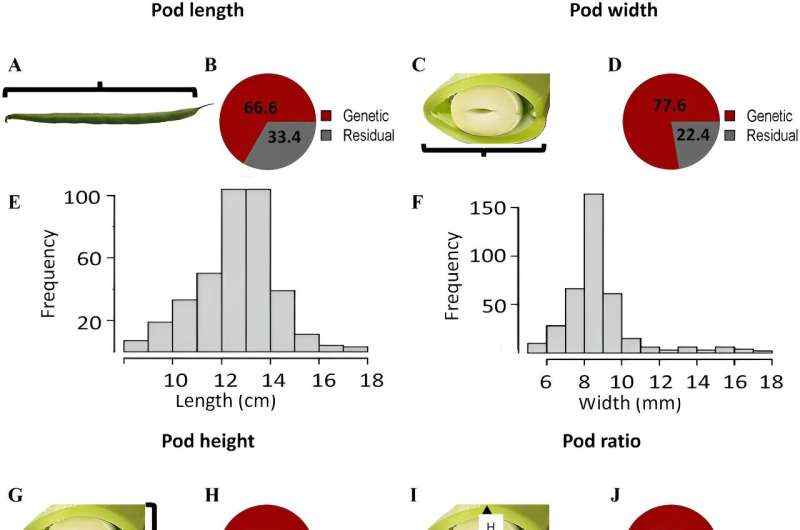This article has been reviewed according to Science X's editorial process and policies. Editors have highlighted the following attributes while ensuring the content's credibility:
fact-checked
trusted source
proofread
Research reveals key genetic factors in snap bean pod traits

Snap beans, the vegetable form of the common bean (Phaseolus vulgaris), are cultivated for their tender, immature pods. They boast a diverse array of pod shapes and sizes. Pod morphology, including shape, thickness, length, and color, plays a crucial role in determining the suitability for fresh markets or processing.
The ideal pod depends on the target market segment. In general, dark green, cylindrical, straight pods that mature at a uniform sieve size are preferred for the canning and packaging sector, which values uniformity and standardization. On the other hand, the fresh market sector, which caters to consumers who prefer fresh produce, prefers a variety of colors and shapes.
For producers of horticultural crops, minimal variation in key traits is critical because products that fail to meet specific standards may be rejected by consumers or processors (USDA 1959, 1990). Uniformity at maturity of beans for processing maximizes the proportion of the harvested product that meets the correct standards of the target market segment and allows accurate grading of the lot through the sieve size. Cultivars with higher pod shape and size variations at harvest time may result in higher pod rejection rates and lower quality of the lots.
A recent study conducted by the USDA-Agricultural Research Service has identified candidate loci that significantly influence the genetic control of pod morphological traits in snap beans. The research team conducted a comprehensive genome-wide association study (GWAS) to pinpoint specific genetic locations associated with pod traits such as pod length, width, and thickness.
The work is published in the journal J. Amer. Soc. Hort. Sci..
The GWAS revealed multiple genomic regions associated with each pod trait, identifying a total of 20 quantitative trait loci (QTLs) for pod length, 9 for pod width, 14 for pod height, and 10 for pod width/height ratio. Notably, these findings corroborate previously reported QTLs for pod and seed traits and highlight the complex genetic control of snap bean pod traits.
The study suggests that a few genomic regions exert a strong influence on pod traits, with additional contributions from multiple smaller-effect regions. Validation of candidate genes identified in associated regions promises to deepen our understanding of legume pod development.
The findings from this study have significant implications for snap bean breeding programs. By harnessing the power of molecular genetics, breeders can now more effectively select for desired pod traits, accelerating the development of improved snap bean varieties with enhanced agronomic performance and consumer appeal.
According to the authors, this research is part of a collaborative effort to contribute to the knowledge about economically important traits in snap bean, a specialty crop that doesn't usually get the spotlight. They began using the panel to investigate herbicide tolerance. Few (herbicide) products are registered in the crop because herbicide manufacturers have limited information on crop tolerance.
The panel was helpful because the diversity of cultivars allowed the researchers to cast a wide net on germplasm herbicide tolerance, but also because of the wide diversity of pod shapes present, they were able to leverage it to explore other important yield and vegetable quality traits. Pod morphology directly impacts the product's commercial uses, so understanding its genetic basis can facilitate the breeding of improved cultivars.
More information: Ana Saballos et al, Genome-wide Association Study Identifies Candidate Loci with Major Contributions to the Genetic Control of Pod Morphological Traits in Snap Bean, J. Amer. Soc. Hort. Sci. (2023). DOI: 10.21273/JASHS05318-23
Provided by American Society for Horticultural Science




















